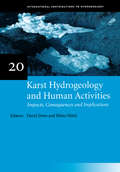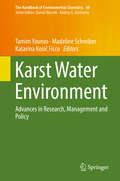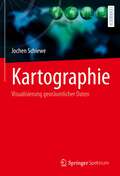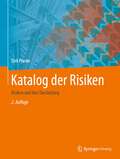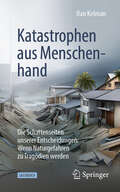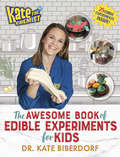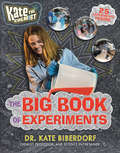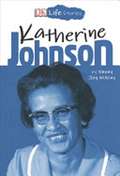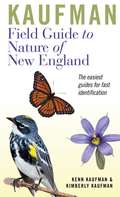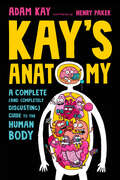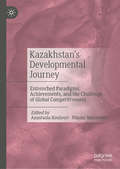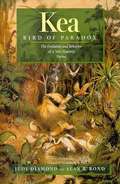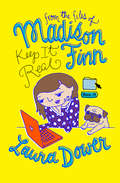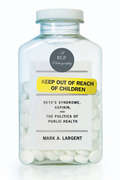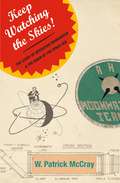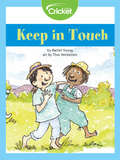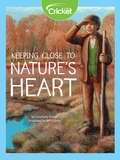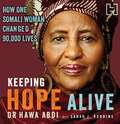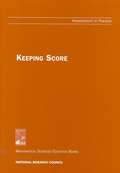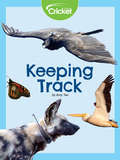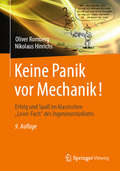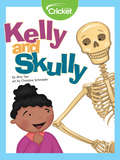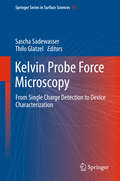- Table View
- List View
Karst Hydrogeology and Human Activities: IAH International Contributions to Hydrogeology 20 (IAH - International Contributions to Hydrogeology #20)
by David Drew Heinz HötzlOne quarter of the world's population lives in karst terrains, yet karsts are highly vulnerable to stresses caused by human activity. This book surveys human impact on karst water, showing that the increasing pollution of the environment has, to a great extent, spoiled sensitive karst ecosystems. This text examines such consequences and offers proposals for future solutions and strategies. Part One provides an overview of the functioning of karsts and of human interaction with karst environments over several millennia. Part Two consists of a systematic examination of the major areas of human activity affecting karst waters, such as agriculture, industry, mining and water exploitation. Finally, Part Three views the effects on karst groundwater within a broader societal and legislative perspective and considers possible changes of methodology and approach.
Karst Water Environment: Advances In Research, Management And Policy (The Handbook of Environmental Chemistry #68)
by Tamim Younos Madeline Schreiber Katarina Kosič FiccoKarst aquifers are important sources of drinking water worldwide. This volume presents a discussion of the current state of knowledge on karst science, advances in karst mapping and karst aquifer monitoring technologies, case studies of karst aquifer assessment, and regulatory perspectives on land use and water management in karst environments. It offers valuable reference material for researchers involved in karst science and environmental studies, as well as a guide for experts at governmental agencies, scientists, engineers and other professionals involved in karst aquifer protection and the design of land and water management systems in karst areas around the globe.
Kartographie: Visualisierung georäumlicher Daten
by Jochen SchieweWie würde unser Leben aussehen, wenn es keine (guten) Karten gäbe?Karten helfen dem Menschen, sich besser und schneller zu orientieren, zu navigieren sowie die komplexe Umwelt auf das Wesentliche zu reduzieren und schließlich besser zu verstehen. Die Visualisierung von georäumlichen Daten unterstützt Laien und Experten bei ihren alltäglichen Aufgaben im privaten, beruflichen oder wissenschaftlichen Bereich. Es werden immer mehr Karten erstellt, dank des Internets immer schneller verbreitet und auf unterschiedlichen Endgeräten wie Smartphones oder Tablets auch im Alltag genutzt. Der Trend zu immer mehr Karten bedeutet allerdings nicht, dass auch immer mehr „gute“ Karten erstellt werden – also solchen Karten, die ihren Zweck tatsächlich effizient erfüllen.Das Buch deckt die ganze spannende Breite des Faches Kartographie ab: Zum einen wird der Kern der Disziplin behandelt, der sich mit der graphischen Kodierung von georäumlichen Objekten und Eigenschaften sowie dem Raumbezug bzw. den Kartenabbildungen beschäftigt. Zum anderen werden wichtige Randbereiche für das „Rundum-Verständnis“ behandelt – z. B. die Überprüfung der Gebrauchstauglichkeit von Karten, die Erfassung und Verarbeitung der zugrundeliegenden Geodaten oder das Kartenrecht. Statt technischer oder Software-abhängiger Beschreibungen legt der Autor den Fokus auf die Vermittlung von Konzepten und Methoden der modernen Kartographie. Hierzu tragen einführende Überblicke zu den Kapiteln, zahlreiche Abbildungen sowie viele Übungsaufgaben bei.Ein wichtiges Lehrbuch, das Studierenden und Lehrenden aus vielen Disziplinen (Kartographie, Geographie oder Geodäsie, Stadt- und Regionalplanung oder Umweltwissenschaften u. v. a.) bei der Gestaltung und Nutzung solcher „guter Karten“ hilft. Auch andere, einfach „nur“ kartenbegeisterte Menschen werden von den hier beschriebenen Grundlagen der modernen Kartographie profitieren.
Katalog der Risiken: Risiken und ihre Darstellung
by Dirk ProskeDie Risikolehre bewertet basierend auf empirischen Daten die potenziell negativen Konsequenzen von Entwicklungen und Handlungen. Sie stellt einen wichtigen Bestandteil der Entscheidungstheorie dar. Neben der Quantifizierung der negativen Konsequenzen gibt die Risikolehre auch die Unsicherheit der Bewertung an. Das Buch beginnt deshalb mit der Diskussion der Begriffe Unbestimmtheit, Komplexität, Katastrophe, Sicherheit und Risiko. Im zweiten Kapitel werden Risiken in natürliche, technische, gesundheitliche und soziale Risiken eingeteilt und zahlreiche Beispiele vorgestellt. Im dritten Kapitel werden verschiedene Risikoparameter eingeführt. Dabei wird der Entwicklung von einfachen Risikoparametern zu komplexeren Parametern gefolgt. Im vierten Kapitel wird die subjektive Risikobewertung behandelt. Im fünften Kapitel werden Lebensqualitätsparameter als höchste Form der Risikoparameter erläutert. Dieser Parameter ermöglicht den eleganten Vergleich der Effizienz von Sicherheitsmaßnahmen. Abschließend werden kurz juristische Grundlagen der Risikobewertung umrissen und Anwendungsbeispiele der Lebensqualitätsparameter diskutiert. Das Buch umfasst eine große Zahl von Bildern und Tabellen, die die Zusammenhänge verdeutlichen sollen. Das Buch besitzt daher den Charakter eines Kataloges.
Katastrophen aus Menschenhand: Die Schattenseiten unserer Entscheidungen: Wenn Naturgefahren zu Tragödien werden
by Ilan KelmanEin Erdbeben erschüttert Haiti und ein Hurrikan wütet in Texas. Wir hören, dass die Natur wütet und versucht, uns durch diese "Naturkatastrophen" zu zerstören. Die Wissenschaft erzählt eine andere Geschichte: die unbequeme Wahrheit, dass Katastrophen nicht die Folge von natürlichen Ursachen sind, sondern die meisten "Naturkatastrophen" durch menschliche Entscheidungen verursacht werden.In diesem Buch erfahren Sie, wie Katastrophen vermieden werden können und sollten. Menschen mit politischer Macht, Geld und Möglichkeiten, allen zu helfen, vermeiden aktiv, Katastrophen zu verhindern, wenn die Natur ihre Kräfte und Energien entfesselt. Sie werden von Beispielen für schreckliche Katastrophen wie Erdbeben und Hurrikane in Haiti lesen, neben inspirierenden Erfolgen im Umgang mit Waldbränden in Colorado und Überschwemmungen in Toronto und Bangladesch. Die Geschichten nehmen Sie mit auf eine Reise um die Welt und in die Vergangenheit, um die komplexen Faktoren zu erkunden, die Katastrophen verursachen. Die Politik diktiert, wo und was wir bauen, während sie Armut, Marginalisierung und Diskriminierung schafft und aufrechterhält. Wir sollten die Menschen, die diese Entscheidungen treffen, für Katastrophen verantwortlich machen. Doch stattdessen konzentrieren wir uns auf Umweltfaktoren oder Gottheiten, die Todesfälle, Schäden und Störungen "verursachen".Die Politik diktiert, wo und was wir bauen, während sie Armut, Marginalisierung und Diskriminierung schafft und aufrechterhält und wir konzentrieren uns auf Umweltfaktoren oder Gottheiten, die Todesfälle oder Schäden "verursachen". Dieses Buch handelt von der Unfähigkeit der Menschheit, mit der Umwelt und mit uns selbst, kollektiv und individuell, umzugehen. Es wird Sie dabei unterstützen, bessere Entscheidungen zu treffen, um zukünftig dazu beizutragen Katastrophen zu verhindern.
Kate the Chemist: The Awesome Book of Edible Experiments for Kids
by Kate Biberdorf25 incredible--and EDIBLE--science experiments to get kids excited about science! Did you know that all cooking is really chemistry? And that chocolate chip cookies will look--and taste--completely different if you swap out baking powder for baking soda? Or swap out brown sugar for white sugar?In this cookbook packed with 25 edible science experiment recipes kids can do in their own kitchen, chemistry professor and science entertainer Kate the Chemist introduces young scientists to the fascinating world of STEM--and cooking! Kids can make their own: • Chocolate-covered pretzels • Rainbow pasta • Ice cream • Pretzel bites • and more! Each recipe includes step-by-step instructions, an ingredients list, full-color photographs, a messiness factor rating, and a note from Kate explaining the science behind each delicious treat.
Kate the Chemist: The Big Book of Experiments
by Kate BiberdorfPacked with 25 incredible science experiments kids can do at home, Kate the Chemist introduces young scientists to the fascinating world of STEM! Have you ever wondered how to make a volcano explode? Or why dropping dry ice in soap bubbles forms neon brains? With 25 kid-friendly science experiments, and stunning full-color photographs, Kate the Chemist's big book of experiments, shows kids just how fun--and easy--it is to be a scientist. Learn how to make slime, fake tattoos, edible snot, and more! Experiments include step-by-step instructions, an ingredients list, full color photographs, a messiness factor rating, and a note from Kate.Create future engineers, scientists, and inventors, and introduce your child to the world of STEM with Kate the Chemist: The Big Book of Experiments!
Katherine Johnson (DK Life Stories)
by Ebony Joy Wilkins Charlotte AgerIn this kids' biography, discover the inspiring story of Katherine Johnson, famed NASA mathematician and one of the subjects of the best-selling book and movie Hidden Figures. <p><p> It was an incredible accomplishment when the United States first put a person on the moon--but without the incredible behind-the-scenes work of NASA mathematician Katherine Johnson, such a feat could not have been possible. In this biography for kids ages 8-12, follow Katherine's remarkable journey from growing up in West Virginia, to becoming a teacher, to breaking barriers at NASA and receiving the Presidential Medal of Freedom in 2015. <p> DK Life Stories go beyond the basic facts to tell the true life stories of history's most interesting people. Full-color photographs and hand-drawn illustrations complement thoughtfully written, age-appropriate text to create an engaging book children will enjoy reading. Definition boxes, information sidebars, fun facts, maps, inspiring quotes, and other nonfiction text features add depth, and a handy reference section at the back makes this series perfect for school reports and projects. Each book also includes an author's introduction letter, a glossary, and an index.
Kaufman Field Guide to Nature of New England
by Kenn Kaufman Kimberly KaufmanWhether you're walking in the woods or along the beach, camping, hiking, canoeing, or just enjoying your own backyard, this book will help identify all your nature discoveries. With authoritative and broad coverage, using nontechnical and lively language, this guide is an essential reference for nature lovers living in or visiting New England.
Kay's Anatomy: A Complete (and Completely Disgusting) Guide to the Human Body
by Adam KayThis complete (and completely gross) guide to the human body is the hilarious debut nonfiction children's book from world-wide multi-million bestselling author and former doctor Adam Kay! Do you ever think about your body and how it works? Like really, really think about it? The human body is extraordinary and fascinating and, well...pretty weird. Yours is weird, mine is weird, your math teacher's is even weirder. This book is going to tell you what's actually going on in there, and answer the really important questions, like:Are boogers safe to eat? Look, if your nose is going to all that effort of creating a snack, the least we can do is check out its nutritional value. (Yes, they're safe. Chew away!)And how much of your life will you spend on the toilet? About a year—so bring a good book. (I recommend this one.) Sit back, relax, put on some rubber gloves, and let a doctor take you on (slightly repulsive) tour of your insides. Welcome to Kay's Anatomy*. *A fancy word for your body. See, you're learning already.
Kazakhstan’s Developmental Journey: Entrenched Paradigms, Achievements, and the Challenge of Global Competitiveness
by Nikolai Mouraviev Anastasia KoulouriThis book discusses Kazakhstan’s transitioning trajectory to a market economy since it declared its independence from the Soviet Union in 1991.. It analyses the evolution of key policy areas and sectors through the lens of policy development and implementation, and evaluates their suitability in pursuing the country’s strategic objectives. Topics include policy initiatives for economic development, new policy paradigms in public service delivery and infrastructure improvement, and water-energy-food (WEF) nexus thinking in governing the WEF sectors. The book argues that policies developed in the 1990s and 2000s have so far served the nation’s needs. Nevertheless, as Kazakhstan seeks to achieve a competitive edge worldwide, many of these policies would require adjustment, or a paradigm shift. Providing a unique outlook on policy and governance, this book will appeal to scholars, students, and practitioners involved with Kazakhstan and Central Asia and interested in the transformation of ex-Soviet nations, their policy, and sustainable development.
Kea, Bird of Paradox: The Evolution and Behavior of a New Zealand Parrot
by Judy Diamond Alan B. BondThe kea, a crow-sized parrot that lives in the rugged mountains of New Zealand, is considered by some a playful comic and by others a vicious killer. Its true character is a mystery that biologists have debated for more than a century.
Keep It Real (From the Files of Madison Finn #19)
by Laura DowerMadison is tired of all the secrets--why can't everyone just keep it real?Madison's not sure if her imagination is working overtime. Everyone--including her mom--is acting different! When Maddie checks out a new feature on TweenBlurt.com, she finds out her keypal, Bigwheels, has been keeping things from her. And then Hart sends a mean email about Madison--is he keeping secrets too?The truth is not always obvious, and Maddie isn't sure how to get the answers she wants. When her mom tells her a secret about Poison Ivy's family, Maddie knows it's serious news, and she's tempted to share it--especially when Ivy is acting mean. But some information is not ours to share . . .
Keep Out of Reach of Children
by Mark A. Largent"Well-researched. . . . A revealing work. " - Kirkus Reviews "A fascinating history of a public health crisis. Compellingly written and insightful, Keep Out of Reach of Children traces the discovery of Reye's syndrome, research into its causes, industry's efforts to avoid warning labels on one suspected cause, aspirin, and the feared disease's sudden disappearance. Largent's empathy is with the myriad children and parents harmed by the disease, while he challenges the triumphalist view that labeling solved the crisis. " - ERIK M. CONWAY , coauthor of Merchants of Doubt "Largent's engaging and honest account explores how medical mysteries are shaped by prevailing narratives about venal drug companies, heroic investigators, and Johnny-come-lately politicians. " - HELEN EPSTEIN , author of The Invisible Cure Reye's syndrome, identified in 1963, was a debilitating, rare condition that typically afflicted healthy children just emerging from the flu or other minor illnesses. It began with vomiting, followed by confusion, coma, and in 50 percent of all cases, death. Survivors were often left with permanent liver or brain damage. Desperate, terrorized parents and doctors pursued dramatic, often ineffectual treatments. For over fifteen years, many inconclusive theories were posited as to its causes. The Centers for Disease Control dispatched its Epidemic Intelligence Service to investigate, culminating in a study that suggested a link to aspirin. Congress held hearings at which parents, researchers, and pharmaceutical executives testified. The result was a warning to parents and doctors to avoid pediatric use of aspirin, leading to the widespread substitution of alternative fever and pain reducers. But before a true cause was definitively established, Reye's syndrome simply vanished. A harrowing medical mystery, Keep Out of Reach of Children is the first and only book to chart the history of Reye's syndrome and reveal the confluence of scientific and social forces that determined the public health policy response, for better or for ill. Mark A. Largent , a survivor of Reye's syndrome, is the author of Vaccine: The Debate in Modern America and Breeding Contempt: The History of Coerced Sterilization in the United States. He is a historian of science, Associate Professor in James Madison College at Michigan State University, and Associate Dean in Lyman Briggs College at Michigan State University. He lives in Lansing, Michigan.
Keep Watching the Skies!: The Story of Operation Moonwatch and the Dawn of the Space Age
by W. Patrick McCrayWhen the Soviets launched Sputnik in 1957, thousands of ordinary people across the globe seized the opportunity to participate in the start of the Space Age. Known as the "Moonwatchers," these largely forgotten citizen-scientists helped professional astronomers by providing critical and otherwise unavailable information about the first satellites. In Keep Watching the Skies!, Patrick McCray tells the story of this network of pioneers who, fueled by civic pride and exhilarated by space exploration, took part in the twentieth century's biggest scientific endeavor. Around the world, thousands of teenagers, homemakers, teachers, amateur astronomers, and other citizens joined Moonwatch teams. Despite their diverse backgrounds and nationalities, they shared a remarkable faith in the transformative power of science--a faith inspired by the Cold War culture in which they lived. Against the backdrop of the space race and technological advancement, ordinary people developed an unprecedented desire to contribute to scientific knowledge and to investigate their place in the cosmos. Using homemade telescopes and other gadgets, Moonwatchers witnessed firsthand the astonishing beginning of the Space Age. In the process, these amateur scientists organized themselves into a worldwide network of satellite spotters that still exists today. Drawing on previously unexamined letters, photos, scrapbooks, and interviews, Keep Watching the Skies! recreates a pivotal event from a perspective never before examined--that of ordinary people who leaped at a chance to take part in the excitement of space exploration.
Keep in Touch
by Rachel YoungOne of our five senses is touch. The sense of touch can help us learn about the world and our surroundings. Test out your sense of touch with these easy experiments.
Keeping Close to Nature's Heart
by Carollyne HutterEvery visitor of Yosemite National Park in California should say "thank you" to one man: John Muir.
Keeping Hope Alive: How One Somali Woman Changed 90,000 Lives
by Dr. Hawa AbdiFor the last twenty years, Dr Hawa Abdi and her daughters have run a refugee camp on their family farm not far from Mogadishu which has grown to shelter 90,000 displaced Somalis: men, women, and children in urgent need of medical attention. As Islamist militia groups have been battling for control of the country creating one of the most dire human rights crises in the world, Dr. Abdi's camp is a beacon of hope for the Somalis, most of whom have no proper access to health care. She was recently held hostage by a militant groups who threatened her life and told her that because she's a woman she has no right to run the camp. She refused to leave.This is not just the story of a woman doctor in a war torn Islamic country risking her life daily to minister to thousands of desperate people, it's also an inspiring story of a divorced woman and her two daughters, bound together on a mission to rehabilitate a country.
Keeping Score: Assessment in Practice
by Ann ShannonKeeping Score is a brief and well organized consideration of effective authentic assessment.-- Teacher Education Materials Project online
Keeping Things Whole: Readings in Environmental Science
by Joseph Coulson Donald Whitfield Ashley L. PrestonWholeness is the key theme of this anthology on the environment. We are one with the natural world, not just with the millions of other living species with whom we share it but also with the elements of air, water, and earth of which we are composed. Sometimes we need to stand back and view our world in perspective from the beginnings of the universe to the littleness of our affairs.
Keeping Track
by Amy TaoDid you know that scientists can track animals? By tracking animals, scientists can see where animals migrate to and from. These trackers can be big or small and are different depending on the kind of animal being tracked. Learn about the different technology that is used for tracking!
Keeping Watch: A History Of American Time
by Michael O'MalleyA history of the transition from natural to mechanical sources for time, Keeping Watch explores the invention of Standard Time Zones and daylight saving as well as the mass production of watches and clocks.
Keine Panik vor Mechanik!: Erfolg und Spaß im klassischen "Loser-Fach" des Ingenieurstudiums
by Oliver Romberg Nikolaus HinrichsDer Begleiter durch das klassische "Loserfach" im Ingenieurstudium. Inhalt des Buches sind die Grundlagen der Mechanik, wie sie im ingenieurwissenschaftlichen Grundstudium behandelt werden, also Statik, Festigkeitslehre, Kinematik und Kinetik, in unkonventioneller, humorvoller Darstellung mit 300 Cartoons und Zeichnungen sowie 99 Übungsaufgaben mit ausführlichen Lösungen. Nach dem Motto: "Schluss mit dem Prüfungsdurchfall!" bleibt trotz der lockeren Darstellungsweise die Korrektheit des Inhalts nicht auf der Strecke.
Kelly and Skully
by Amy TaoKelly's grandmother is a doctor who has a scary-looking skeleton named Skully in her office. One day, Skully comes to life and explains to Kelly all the important things a skeleton does. Suddenly, Skully isn't so scary anymore.
Kelvin Probe Force Microscopy: Measuring And Compensating Electrostatic Forces (Springer Series in Surface Sciences #48)
by Sascha Sadewasser Thilo GlatzelThis book provides a comprehensive introduction to the methods and variety of Kelvin probe force microscopy, including technical details. It also offers an overview of the recent developments and numerous applications, ranging from semiconductor materials, nanostructures and devices to sub-molecular and atomic scale electrostatics.In the last 25 years, Kelvin probe force microscopy has developed from a specialized technique applied by a few scanning probe microscopy experts into a tool used by numerous research and development groups around the globe. This sequel to the editors’ previous volume “Kelvin Probe Force Microscopy: Measuring and Compensating Electrostatic Forces,” presents new and complementary topics.It is intended for a broad readership, from undergraduate students to lab technicians and scanning probe microscopy experts who are new to the field.
